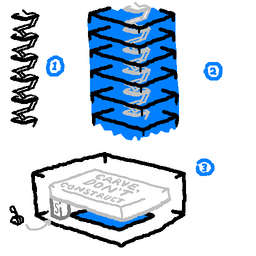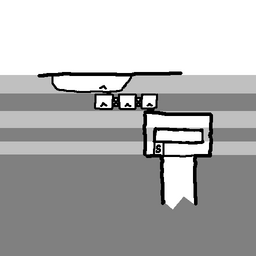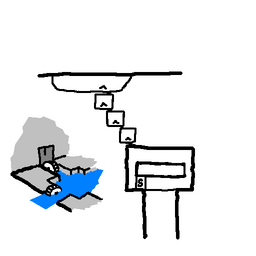v50 Steam/Premium information for editors
- v50 information can now be added to pages in the main namespace. v0.47 information can still be found in the DF2014 namespace. See here for more details on the new versioning policy.
- Use this page to report any issues related to the migration.
This notice may be cached—the current version can be found here.
User:MAJORELLE BLUE
Jump to navigation
Jump to search
Constructions[edit]
Do Everything In 3*3 Units[edit]
- This is ideal because most buildings are 3*3.
Why Not Make Every Similar Element Out Of The Same Kind Of Stone[edit]
- Seriously, what do you have to lose at this point
- V. Hard Mode: Each furnishing can only be made of the kind of stone it will be placed on, as if the fort was carved out of the mountain in one piece.
Dumbwaiter[edit]
- A retracting bridge placed over a 1*1*n square drop upon which materials gathered from the outside may be dumped. After all wanted materials are on the square, the bridge is triggered and they fall to their destination, where they may be reclaimed. Testing is needed to find the viability of this method with manufactured objects. NOTE: does not appear to work with wood, vast amounts were lost.
Obsidian Plugging[edit]
- Obsidian can be used to cast engravable structures, as opposed to built walls and floors. It can also be used to fill unwanted and abandoned rooms.
Magma Mist Shells[edit]
- Multiple floors stacked above a magma pool that can fall on trigger. Need to tweak it so that a single lever will go to each floor in turn.
【 ҂゚_ゝ゚】 02:34, 13 November 2009 (UTC)
A Map-Wide Catastrophe[edit]
- Map-spanning trays can be constructed above each other, walled on every edge and connected to a tower by single destructible tiles. Each tray is two z-levels deep, and will be separated by a single z-level, all the way up. The trays will be flooded, alternating between magma and water. The dwarfs will be invited inside and the trays dropped, engulfing the land in magma mist, regular mist, cave-in dust, and hatred.
Drain the God Damn Ocean[edit]
- --and fill it with obsidian.
【 ҂゚_ゝ゚】 06:40, 14 November 2009 (UTC)
Magma Mist Shells Redux[edit]
- Somehow mix water and magma in mid-air above magma so that when they form obsidian, it hits the magma and creates mist.
Untitled Trap #1[edit]
- Just a long, zig-zagging path with drop-away floors and a hall cut down the center for caravans and maintenance. Floodgates serve for the zig-zag's missing walls and force intruders to take the long way across the booby-trapped floors. The space under them could flood or have skeletal camels in it.
【 ҂゚_ゝ゚】 10:58, 12 December 2009 (UTC)
Tip! Save Travel Time[edit]
- If you've just taken down a wall and want to use the stone for something nearby, but can't because it's immediately marked for hauling to stockpile, just pause the game, forbid the stone, resume playing for a few seconds, pause again, and unforbid the stone. If you stay paused until you're done marking the location of the new wall, you'll be able to use the nearby stone for it, instead of some kind of Elven fire drill* with people running everywhere carrying rock. This is also good if you want to dump the rock, or if you need to do similar things with objects that aren't rock.
*They live in trees, you see.
【 ҂゚_ゝ゚】 03:45, 14 December 2009 (UTC)
Reservoir For Linking Multiple Small Disconnected Pools To Cistern[edit]
The Cistern.[edit]
- Before linking the pools, a cistern should be constructed below them with at least one z-level of material between the ceiling of the topmost room and the floor of the pools, to allow for the accumulation system. The cistern/reservoir can be made by carving out a stairway as deep as you want it to be, mining out a room around it on each z-level, and mining out a room at least one unit larger in all directions at the top of the reservoir.
- The purpose of this larger room is to create a floating slab of rock one z-level tall that will be held up only by a support as soon as it's cut free of the surrounding stone. Triggering the support will allow the slab to plummet into the reservoir, destroying each unwanted floor with slightly less time consumption, micromanagement, and potential for injury than simple channeling. If you're strapped for vertical space, a floor might suffice in place of the "thicker" slab, but could leave the occasional magical free-floating square of floor or wall of rock.
The Accumulator Tunnels.[edit]
- To build the accumulator, mine out chains of 3*3 rooms, leading from the area under each pool to the area above the reservoir. It's probably a good idea to make sure there's as little space between each room as possible, so as to minimize the amount of water that will evaporate off in transit. The opposite of this would be a bunch of 1-unit-wide tunnels, leading to the pit, under each pool. It wouldn't work very well.
- Once you have all of the rooms linked to the central reservoir, carve ramps up into the floors of the pools to drain them into the pit. When they're drained, put hatch covers over each of the ramp openings and a pressure plate in every pond, set to activate at water depths of min=6/max=7. Link them up and put pressure plates with the same settings in the center of each 3*3 accumulator room. After this, place exactly one floodgate between each room and link them to the plates such that each room's plate, leading from the first rooms under the ponds to the destination reservoir, controls the floodgate "ahead" of it. This will allow each room to flood in order, "buffering" the water flow. Oh, and maybe some way to turn it off once the reservoir is full, too.
Other Methods.[edit]
- A secondary method that largely substitutes hatch covers and overlapping holes for floodgates can be used, if you have vertical space to spare and need intense water pressure. If the physics behind waterwheels are sufficiently accurate, the design shown in the illustration detail could harness this for power.
【 ҂゚_ゝ゚】 13:37, 4 January 2010 (UTC)



